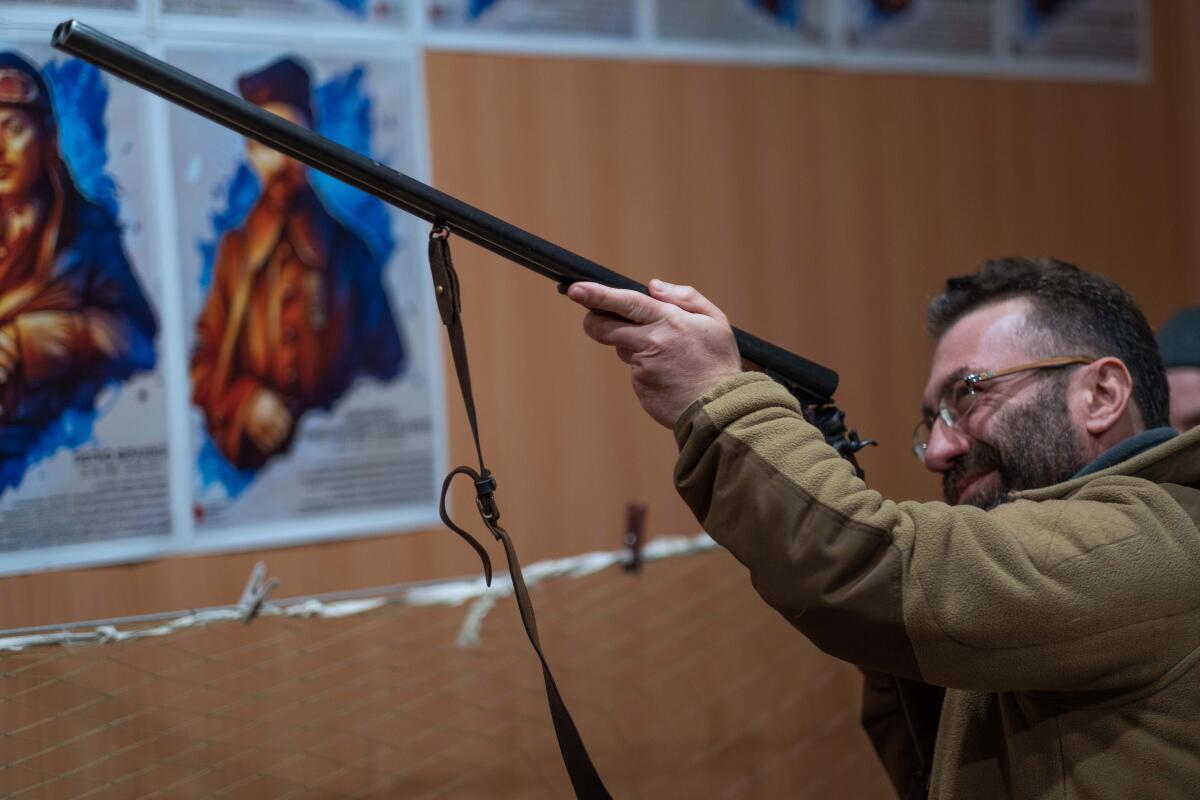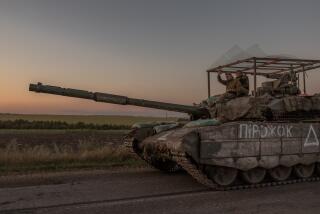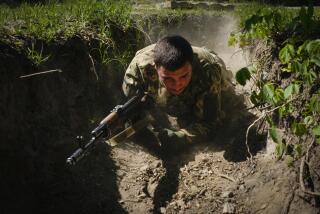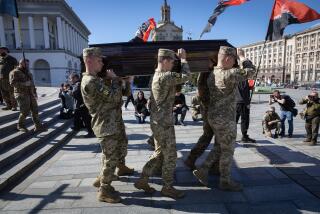‘Everything that needs to be done’: Ukraine citizen soldiers prepare for Russia threat

- Share via
MARIUPOL, Ukraine — In normal life and in normal times, Valeriy Averyanov is a businessman. But these days, his main preoccupation is making preparations for what he and his neighbors would do if Russian troops attacked their hometown, a prosperous but rust-riddled industrial port in southeastern Ukraine.
Averyanov, who cradled a shotgun as he spoke, heads a military-civil group in Mariupol, a city of about half a million people that sits by the strategic Sea of Azov. If Russian forces moved in, either by land or sea, his local militia would transform itself into “partisan groups that could operate behind enemy lines,” he said.
“In the event of a brutal invasion, everything that needs to be done will be done,” said Averyanov, a short-statured 46-year-old with a ferocious smoking habit and an intense stare.
With more than 100,000 Russian troops massed near Ukraine’s borders and tense diplomatic talks unfolding daily, thousands of volunteers across the country are joining Ukraine’s newly reconstituted Territorial Defense Forces, which come under the wing of the Ukrainian military but whose ranks are being bolstered by ordinary civilians.
In cities and towns across this country of 40 million people, Ukrainians from all walks of life — accountants and teachers, shopkeepers and software engineers — are making ready for possible war. Under the instruction of regular Ukrainian troops and army veterans, these citizen soldiers stage weekend drills in snowy woods and fields, heft wooden model guns or real ones, rush to offer simulated medical aid, drop to their bellies and crawl through mud.
Senior Ukrainian military officials have welcomed the existence of locally organized groups to support the war effort, should it come to that.
“No one must stand aside when it comes to the security of their home, village, city and their country as a whole,” Gen. Yuriy Halushkin, the recently appointed commander of the Territorial Defense Forces, told the state news agency Ukrinform this month.
Mariupol, the site of a historic Cossack encampment, could find itself a prime target if hostilities were to break out, military experts say. It is 25 miles from the Russian border, and even closer to the front lines of the years-old conflict between Russia-backed separatists and Ukrainian forces. The Sea of Azov’s shores touch Ukraine and Russia as well as Crimea, the strategic peninsula Russia invaded in 2014 and then illegally annexed.
In the event of a fresh invasion, an early Russian strike could involve amphibious operations to seize the coastline between Mariupol and Crimea, retired Lt. Gen. Ben Hodges, the former commander of the U.S. Army in Europe, wrote in a recent paper for the Center for European Policy Analysis.
“The operational objective in the first days will be the isolation of Ukraine from the Azov Sea and the Black Sea, with main operations focused along both coastlines,” Hodges wrote.
Or Russia could target Mariupol under the auspices of separatist forces, thus giving it a measure of deniability of responsibility. Averyanov, for one, believes that such a provocation is likelier than a direct assault.
The Territorial Defense Forces, while operating under new organization, date back to 2014, following the last Russian invasion. Originally set up to train part-time military reservists after the seizure of Crimea, drawing backing and membership from the protest movement that galvanized the country’s pro-democracy revolution, the defense forces were formally expanded last year to encompass civilian participation.
No one thinks these defensive units would have any chance of staving off the Russian army, but military experts say they could form a kind of insurgent rear guard, harassing and disrupting invading forces. Those are precisely the types of guerrilla operations that evoke unhappy memories in Moscow of protracted, bloody conflicts of attrition in the past, like those in Afghanistan and Chechnya.
“Ukraine can raise the cost to Russia by preparing for a long war complete with significant guerrilla activity behind Russian lines,” T.X. Hammes, a research fellow at the U.S. National Defense University, wrote last month on the Atlantic Council’s UkraineAlert blog.
While the Ukraine leadership, including President Volodymyr Zelensky, has sought to present a calm front in the face of the invasion threat, the Biden administration has been far more blunt in assessing the likelihood of Russian President Vladimir Putin making a significant military move.
At the Pentagon on Friday, Defense Secretary Lloyd J. Austin III said the buildup of troops, armor and artillery along Ukraine’s borders gave the Russian leader a range of options.
“While we don’t believe that President Putin has made a final decision to use those forces against Ukraine, he clearly now has the capability,” Austin told reporters.
In Mariupol, one of the gargantuan steelworks dominating the port is named for Vladimir Ilyich Ulyanov, better known as Vladimir Lenin, the first head of the Soviet state. But some in this largely Russian-speaking city find it a point of irony that Putin has been an unwitting booster of Ukraine’s sense of its own sovereignty.
The country’s increasing tilt toward the West, and its aspirations to someday join the North Atlantic Treaty Organization, are in large measure due to the Kremlin’s relentless propaganda campaign painting the former Soviet republic as a pit of treachery and a source of aggression, many analysts and observers say.
“Ukrainian democracy today, not Ukrainian membership in NATO in some distant future, is the real threat to Putin,” Michael McFaul, a former U.S. ambassador to Russia, wrote on Twitter this month.
While smoke-belching steel, iron and metallurgy plants lend Mariupol’s industrial zone a dystopian air, the city — a lively metropolis with distinctive architectural features imparted by past waves of Greek immigration — remains economically important as well as strategically significant.
It lies along a potential land bridge from Russia to Crimea, and its port provides a logistical lifeline for whoever controls it. Its defenders — both the regular Ukraine army and the irregular forces mustering for battle — are keenly aware of that.
“We are always ready,” said Averyanov. “To lose this city would really put Ukraine on its knees.”
Special correspondent Adler reported from Mariupol and Times staff writer King from Washington.
More to Read
Sign up for Essential California
The most important California stories and recommendations in your inbox every morning.
You may occasionally receive promotional content from the Los Angeles Times.










